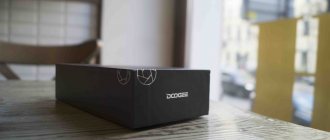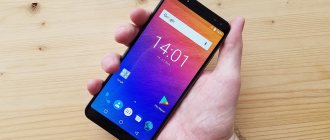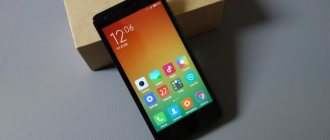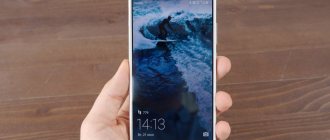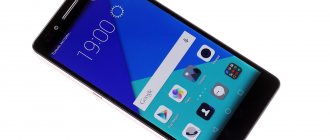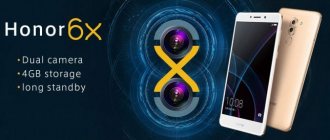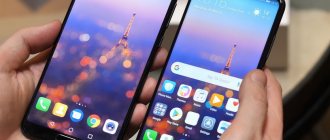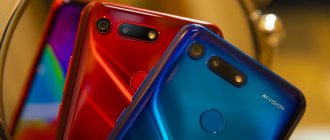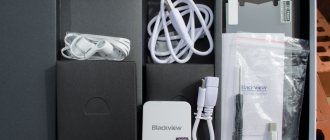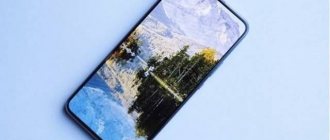The Chinese company Doogee made its debut on the market in 2013 and has been rapidly gaining momentum since then. At the moment, the company’s product range is represented by a wide variety of devices, from budget “dialers” to secure “business devices” in crocodile skin cases. Today we are reviewing the T6 Pro model; it occupies a middle position in the company’s lineup, but is no less interesting and can even pleasantly surprise in some aspects.
The best Telegram channel about technology (possibly)
Specifications
- Screen: 5.5″, IPS, resolution 1280×720;
- Processor: MT6753, 8 cores ARM Cortex-A53 clocked at 1.3 GHz;
- Graphics accelerator: Mali-T720;
- Operating system: Android 6.0;
- RAM: 3 GB;
- Built-in memory: 32 GB;
- Memory card support: MicroSD up to 32GB;
- Communication: 2G (GSM): 850 / 900 / 1800 / 1900 MHz; 3G (WCDMA): 900 / 2100 MHz; 4G (FDD-LTE): B1(2100) / B3(1800) / B7(2600) / B20(800)
- SIM: 1 Micro SIM slot, 2 slot – Micro SIM or memory card;
- Wireless interfaces: WIFI (802.11 b/g/n), Bluetooth 4.0;
- Navigation: GPS, A-GPS, GLONASS;
- Cameras: main – 13 MP (autofocus), front – 8 MP;
- Battery: 6250mAh, non-removable;
- Dimensions: 154×77.1×9.9mm;
- Weight: 170 grams.
Review of the Doogee T6 Pro Android smartphone: you can never have too much autonomy
Table of contents
- Introduction
- Specifications
- Packaging and equipment
- Appearance and design
- Display
- Hardware platform and performance
- Software and firmware
- Multimedia
- File system
- Wireless Interfaces and Communications
- Battery life
- Camera
- Comparison with competitors
- Conclusion
- Additional photos
Introduction
Long-lived smartphones have firmly established themselves in the modern market and are not going to lose ground.
Almost all manufacturers offer their models in this segment. Some of them are trying to achieve autonomy by developing smart programs to save charge, intelligently control the operation of the SoC, and so on. Others act much more simply, acting on the principle “the larger the battery, the longer it takes to discharge.” In general, this is how it is. The Doogee company took exactly this path, releasing a smartphone, when creating which they did not think about weight or dimensions, but were generous with battery capacity. This is the successor to the Doogee T6 already reviewed in the laboratory.
And since a 6,250 mAh battery in a smartphone with a 5.5″ display is not so common, it’s worth finding out how effective such a solution turned out to be and whether it is not inferior to its predecessor.
The Doogee T6 Pro smartphone appeared in our laboratory thanks to the Chinese online store GearBest.com, which also runs a specialized section at our conference: the Gearbest.com forum on Overclockers.ru.
announcements and advertising
2080 Super Gigabyte Gaming OC for 60 rubles.
Compeo.ru - the right comp store without any tricks
RTX 2060 becomes cheaper before the arrival of 3xxx
Ryzen 4000
series included in computers already in Citylink
The price of MSI RTX 2070 has collapsed after the announcement of RTX 3xxx
Core i9 10 series is half the price of the same 9 series
The price of memory has been halved in Regard - it’s more expensive everywhere
Technical characteristics of Doogee T6 Pro
| Model | Doogee T6 Pro | Doogee T6 |
| CPU | MediaTek MT6753, 8 x 1.3 GHz, Cortex-A53 | MediaTek MT6735P, 4 x 1.0 GHz, Cortex-A53 |
| Video processor | Mali-T720 | Mali-T720 |
| operating system | Android 6.0 | Android 5.1 |
| Memory, GB | 3 RAM; 32 ROM | 2 RAM; 16 ROM |
| Screen | 5.5″ IPS, 1280 x 720 | 5.5″ IPS, 1280 x 720 |
| Cameras, Mpix | 13.0 + 5.0 | 8.0 + 2.0 |
| Net | GSM; WCDMA; LTE | GSM; WCDMA; LTE |
| Number of SIM cards, pcs. | 2, microSIM | 2, microSIM |
| MicroSD support | Yes, (instead of one of the SIM cards) | Yes, (instead of one of the SIM cards) |
| Data transfer | Wi-Fi; Bluetooth | Wi-Fi; Bluetooth |
| GPS/aGPS/EPO/GLONASS | Yes Yes Yes Yes | Yes/Yes/Yes/No |
| Battery, mAh | 6 250 | 6 250 |
| Dimensions, mm | 154.0 x 77.1 x 9.9 | 154.0 x 77.1 x 9.9 |
| Weight, g | 228 | 228 |
| price, rub. | ~10 000 | ~9 000 |
Considering the price segment, the technical characteristics can be called quite good. Compared to the previous model, the manufacturer has improved the hardware platform and added more memory. And if you remember the positioning of the hero of the review, you can forgive the low resolution of the display and not the most modest mass.
Packaging and equipment Doogee T6 Pro
The Doogee smartphone comes in a medium-sized cardboard box. Structurally, it is a traditional box with a lid. There are no complaints about the quality of the material used - you don’t have to worry about the safety of the contents.
The design is dominated by white color, taken as the background. The front side shows the device itself, the model is indicated in the blue area below, as well as the display diagonal and battery capacity.
From the back you can see the main characteristics of the device. As is usual with many Chinese brands, the box is devoid of factory seals.
Inside we are immediately greeted by the device itself; it is recessed into a special stand-shape and firmly fixed in its place. A transport protective film is glued to the display, with a regular one underneath.
Below we find a small flat box with the delivery kit. In addition to the standard accessories, several more items have been added here.
The package includes:
- Power adapter:
- USB-microUSB cable;
- USB-OTG cable;
- Protective case;
- Spare display film;
- Clip for opening the SIM card tray;
- Technical documentation.
The packaging performs its function perfectly and will ensure the safety of the contents during transportation without any problems, and nothing more is required from it. A nice feature was the presence of additional accessories included in the package, thanks to which you do not have to buy a cover or film separately.
Now let's turn our attention to the hero of the review.
Equipment
The device comes in a thick cardboard box with a fairly minimalistic design. In the package you can find almost everything you need to service your phone: a USB cable, an adapter, and a bag with additional small items. A pleasant fact is that among the “little things”, in addition to a paper clip and an adapter for a SIM card, you can find an additional protective film for the screen, a cloth for wiping the glass, OTG and a simple transparent case made of soft polymer. The OTG cable allows you to connect external drives and even charge other devices. A simple case will be enough to protect your smartphone for the first time after purchase, until you purchase something more convenient. What was surprising was the absence of even the most primitive wired headset.
Doogee DG580 vs Thl T6 pro - a battle of interesting budget devices, review - comparison.
Greetings! I'm always thinking about how to make my reviews not only informative, but also interesting. Today is an experimental review in the “battle” format: a battle between two popular budget products that are in the same price category, but quite different in concept and technical characteristics. I will compare smartphones and give them a certain score, where 5 is the maximum and 1 is the minimum. And at the end I will summarize everything in a small table in which you will find out the final result. To avoid unnecessary talk, I’ll say right away that the Doogee smartphone was provided to me by the Banggod store for free to write a review; I chose the phone model myself. The second smartphone was purchased with my own money from the Coolicool store. I am writing this for information and in no way am I advocating for any store. Everything that will be written below concerns only smartphones, and everyone will decide for themselves how to use the information. Smartphones cost almost the same: Dg580 - $115.99, and Thl T6 pro - $118, both are positioned as budget phones, but their technical characteristics differ significantly.
Technical characteristics of Doogee DG580
General Brand
DOOGEE
Model
Kissme DG580
Frequency
2G: GSM 850/900/1800/1900 3G: WCDMA 850/1900/2100
Data transfer
GPRS, HSPA, EDGE
SIM
Type Ordinary SIM, Micro SIM
GPS
Yes
Wi-Fi
802.11b/G/N
Operating system
Android 4.4
CPU Processor
MTK6582 1.3GHz
Processor type
Quad-core processor
GPU
Mali-400MP
RAM
1GB
ROM
8GB
Memory available
6.3GB
Memory cards
Support Micro SD/TF cards up to 32GB
Screen
5.5 IPS OGSinch
Screen resolution
960 x 540
Camera
8.0MP
Video
1080P
Flash
Yes
Autofocus
Yes
Battery capacity
2500mAh Other features
Bluetooth
V4.0
FM
Yes
Size
15.8 cm x 7.87 cm x 0.86 cm
Weight
149.6
Technical characteristics of Thl T6 Pro
OS
: Android 4.4.2
Processor
: 8-core, MTK6592M
Processor frequency
: 1.4GHz
Graphics
: OpenGL ES 2.0, Mali-450 MP4
Screen size
: 5.0″
ROM
: 8GB
RAM
: 1GB
3G
: WCDMA 900MHz, WCDMA 2100MHz
2G
: GSM 850MHz , GSM 900MHz, GSM 1800MHz, GSM 1900MHz
Screen Resolution
: 1280 x 720 pixels
Screen Type
: HD, IPS, 720P, touch screen, Capacitive
touch
: Five Points
Battery
: 1900mAh, 4.2V, Li-ion
SIM card
: Standard SIM card with support 3G, Micro SIM card
Data transmission
: GPRS, EDGE, HSPA, HSPA+
Rear camera
: Rear 8.0 MP
Front camera
: Front 2.0 MP
GPS
: GPS, AGPS
Sensors
: Gravity sensor, Proximity sensor, Light sensor
WIFI
: Wi-Fi Hotspot , WiFi 802.11 b/g/n
Bluetooth
: Bluetooth 4.0
Ports
: Micro USB, 3.5mm Audio jack, TF Card slot
Dimensions
: 143 x 71 x 9 mm
Weight
: 155 g (with a battery)
I also made a short video review for each smartphone. They are basically the same thing, only in video format. If you like to read more, you can skip it - everything is the same in the text review. Video review of Thl T6 Pro
Video review of Doogee Kissme DG 580
As you can see, despite the same cost, we have two completely different devices. But which one is better? I still don’t know about this myself, because I haven’t added up the amount of points scored. We will learn about this at the very end. Our battle begins!!! The boxes of both smartphones are made of thick cardboard, which perfectly protects the contents from damage. Both boxes have a simple, no-frills style, with the technical specifications of the device listed on the back. 4 points for each in the piggy bank, for the maximum there is not enough originality.
But which one is better? I still don’t know about this myself, because I haven’t added up the amount of points scored. We will learn about this at the very end. Our battle begins!!! The boxes of both smartphones are made of thick cardboard, which perfectly protects the contents from damage. Both boxes have a simple, no-frills style, with the technical specifications of the device listed on the back. 4 points for each in the piggy bank, for the maximum there is not enough originality.
Equipment. Here doogee gets 3 points for 2 films (one pasted on the display + 1 spare), headphones, USB cable, instructions. Thl has, in addition to the above, a plastic cover - a bumper, for which it receives one point more (4 points).
Chargers deserve special attention. Both are not perfect, they have flaws, so they get 2 points. The charger on the DG 580 has a maximum charging current of 1000 Mah, which is quite good with a 2500 battery, but my keen hearing is very susceptible to the squeaking sound produced by charging. I couldn’t sleep in a room with a charging phone, I had to take it to the kitchen - I clearly heard the charge impulses ((My wife didn’t hear anything. The T6 Pro turned out to be silent charging, but its maximum current is only 500Mah, which significantly increases the time of full charging a smartphone.
Now that we've sorted out the equipment, let's move on to the appearance. It’s not easy to evaluate here, because design is a purely individual preference, so I won’t give ratings for this item. I won’t say which one I liked better either. Let me show you some interesting features. Dg 580 is a copy of the design of the popular One Plus One model. The frame of the phone has a metal-look edging; in my opinion, it’s chrome-plated plastic. Pleasant, slightly rounded shapes, original, rough back cover reminiscent of artificial stone to the touch. The touch buttons are in the usual sequence: menu, home and back - without backlight. The LED near the front camera is an event indicator. The buttons are located on different sides: lock on the right, volume on the left. The connectors are located on the top. For ergonomics, comfort, grip and tactile sensations I give the smartphone 4 points.
Thl T6 Pro inherited its design from T6S, which in turn borrowed it from someone else. In general, the design is also not original. Metal inserts on the sides, rounded top and bottom of the smartphone. Back cover with matte texture. The layout of the buttons and connectors is similar to that of the competitor, the backlighting of the touch buttons is also absent, but an event indicator in the form of a red LED is present. I give it a solid 5 for ergonomics; it fits comfortably in the hand.
In general, the design is also not original. Metal inserts on the sides, rounded top and bottom of the smartphone. Back cover with matte texture. The layout of the buttons and connectors is similar to that of the competitor, the backlighting of the touch buttons is also absent, but an event indicator in the form of a red LED is present. I give it a solid 5 for ergonomics; it fits comfortably in the hand.
However, I deduct 1 point from THL for the camera being too protruding. Carrying this phone without a case may result in a broken or scratched lens. The included case solves this problem and reliably protects the camera, but not everyone will use it.
photos of smartphones together for comparison
Let's look under the skirt up to the lid. The cover can be removed quite easily and is secured with latches. For build quality I give both phones 5 points. No creaks, backlashes, gaps - everything is very neat. Having removed the cover of the doogee, we will see a rather small battery, with a declared capacity of 2500 Mah. You can see 2 slots for SIM cards: standard and micro, as well as an expansion slot for micro SD memory cards. Under the camera we can see 2 LEDs for illuminating photos, videos, and also for use as a flashlight.
Thl hides under its cover a very modest battery with a capacity of only 1900 Mah, the same SIM card slots: standard and micro, and of course, memory expansion with micro SD cards. There is only 1 LED under the camera, but I won’t draw any conclusions just yet, the tests will show the real result.
Let's move on to the main section - using smartphones in real conditions, as well as tests. First of all, the impression of a smartphone is formed from the screen, so let's start with that. Doogee has a 5.5-inch display with a qHD resolution of 960 x 540 pixels. Many will say that for such a diagonal this is a small resolution, there will be a lot of grain, etc. But in reality, the screen surprised me: the pixels are not noticeable, the graininess is not large, and thanks to the IPS OGS matrix with a backing, the screen looks great! Viewing angles are excellent, colors are transmitted without distortion when changing the angle of inclination, the picture looks very rich. The brightness reserve is very large, but I would like to reduce the minimum brightness a little. On the street the picture does not fade. I give the screen 4 points only for its non-HD resolution.
Viewing Angles
Thl T6 Pro, with a smaller screen size, has a higher screen resolution - HD 1280 x 720 pixels. The matrix is also made using IPS technology, but the screen is not OGS. Brightness is high, the minimum threshold is comfortable for night reading. Overall the screen looks great, for which it gets 5 points.
However, if you put both phones side by side, you won't notice much of a difference. Both screens perform very well. The only difference is the color rendering: in Doogee it is warmer, in Thl it is neutral. In the following photos you can compare the screens with each other.
Let's move on to performance. Here the advantage is entirely on the side of the Thl T6 Pro; it is worth noting that this is generally one of the most affordable 8-core processors. In the Antutu benchmark it shows amazing results for its price category! For performance 4 points (2 GB of RAM is not enough for complete happiness)
Additional information from Antutu
Doogee cannot boast of such impressive results, but its performance is sufficient for most modern tasks, viewing high-definition video content, comfortable surfing and games, including modern 3D games (the latest games may require medium or minimum graphics settings). Asphalt 8 - flew without problems on standard graphics settings. 3 points for performance.
Additional information from Antutu
To complete the picture, I’ll also post the results of the velamo benchmark. Here the performance difference is not so noticeable.
Both smartphones pleased us with a responsive 5-touch touchpad. The sound of the main speaker is also at the same level - clear and loud, without wheezing at maximum volume. Since they are equally good at this, I won’t give ratings. But where they differ is the launcher and other goodies. Thl has Android 4.4.2 installed with an almost standard set of gaps, there is no Chinese stuff, the only interesting thing is the multitasking window, when enabled we get an additional pop-up menu with some functions implemented in windowed mode (hello windows). 3 points is a good result.
But Doogee has seriously improved the standard Android 4.2.2. In addition to standard functions, the developers have added many original ones, for example, unlocking with a double tap, launching any assigned applications using a symbol drawn on the switched off screen. You can protect any folder, application, or even action with a password. The smartphone can be configured for one-handed use (the dial pad moves to the left or right). In addition, you can customize the pop-up menu by adding what you need to it. In general, they approached thoroughly. The only thing that spoils the picture a little is that all these additional functions are not translated and are displayed in English, while the standard Android functions are in Russian. Developers are constantly working on firmware and perhaps this will be fixed in the near future. For example, yesterday I received another firmware via wifi, promising to fix some bugs. 4 points (minus 1 point for undertranslation).
Screenshots with additional features described above
There is no Chinese here either, but some additional applications are installed that can be easily removed if desired. WiFi and GPS in the device work at the same level, I will characterize it as good. Now let's talk about the quality of communication, the quality of the conversational speaker - I liked the Doogee better, the speaker reproduces a more natural voice, the THL is like a barrel. I send 1 extra point to the DG 580. The microphones are good in both models, the interlocutor notes normal voice audibility.
Let's move on to the camera. We will compare the main camera. An 8 megapixel sensor is installed in both places. The cameras shoot at approximately the same quality; the pictures depend very much on the lighting. Focus drops around the edges, but overall the photo quality is good. Here are the pictures taken with the DG 580. Pictures without enhancements, taken in haste, without selecting the best ones. Weather: cloudy, snowing.
Here are more photos
And this is how the THL T6 pro shoots. The pictures were taken a few days before the snowfall. The weather is cloudy.
More photos
Some may think that Thl shoots a little better, but this is not the case. Upon closer examination of the photographs, absolutely identical flaws are visible, they just look more noticeable in snowy photos. For clarity, the following photos are for comparison in approximately equal conditions. (Doogee on the left, Thl on the right) View from the balcony
Artificial lighting in the apartment.
I give the cameras 3 points.
In complete darkness, both take pictures no matter, but Doogee has a more powerful flash. 2 LEDs versus 1 for Thl. In complete darkness, doogee takes the following photos:
But Thl can’t even focus in the dark, so the photo didn’t come out. I give THL 1 point for the flash, 2 points for the competitor (the LEDs are still not very bright).
Macro photography is amazing in both devices. Both text and pictures turn out very clear, focusing occurs from about 5 - 6 centimeters.
Macro photography examples
It was Dougie, and here is Thl:
But with the video, not everything is so clear. Here is a video recorded on a DG 580, Full HD resolution, 30 frames per second, cloudy, snowing:
Thl really upset me. When recording in full HD quality, the speed is only 15 frames per second.
For the video I give 1 THL point and 2 Doogee points.
The sound in headphones (not included) in smartphones is the same; it’s suitable for listening to music on the road. Of course, it’s a long way from HiFi, but with the help of a good player, such as poweramp, and an equalizer, you can achieve good results. I give both 3 points.
The last thing I would like to talk about, but far from least important, is the operating time on a single charge. Doogee has a larger battery - 2500 Mah, but also a larger screen size, as well as a less energy efficient processor, so not everything is as clear as it might seem at first glance. After conducting tests with the Antutu battery tester benchmark, I got these results.
Yes, a miracle did not happen and the larger battery showed the best result. However, the result is not much different. True, this is only based on synthetic tests. In reality, with active use, the Doogee DG580 lasts for a day, with about 30% remaining in the evening. In average use mode it lasts for 2 days. But the Thl T6 Pro in active mode does not last until the evening; in medium use mode it can last a day. For such a weak result, the smartphone gets a score, and its competitor gets 3 points.
Well, that's basically all. Instead of conclusions, let's compare the result. I organized all the data and put it into a table.
Thank you for attention! Respect, if you were able to master the entire text - I tried to shorten the review as much as possible and indicate only the necessary and important information. In the comments, ask your questions regarding smartphones, and also leave your wishes. I would also like to hear your opinion about the review format. Did you like this format or is it better to write as before? Let me remind you about smartphones (I indicated at the very beginning of the review): THL T6 pro was purchased at the coolicool store with my own money, Doogee DG 580 was provided for review free of charge. I am in no way promoting a purchase in any store, I have only provided you with information that you are free to dispose of as you wish.
Appearance
T6 Pro has a classic rectangular shape, strongly rounded at the edges. At the top of the screen there is a camera, earpiece and sensors; at the bottom there are touch buttons for “home”, “step back” and “menu”.
The power off and lock button is located on the right side of the device, just above are the volume buttons. The location of the buttons is quite convenient and familiar - you won’t have to adapt to something fundamentally new. On the top edge of the device there is a 3.5 jack for a wired headset and headphones, on the bottom there is a USB port.
On the left side there is a retractable slot for SIM cards and memory cards. The microSD slot is combined with the second SIM card slot. The “pallet” is made of metal and looks quite reliable.
On the back side there is the main camera and multimedia speaker. The body material is completely made of plastic. The quality of the plastic is quite difficult to praise; for example, the back panel of the device bends quite a lot under pressure. On the other hand, the rest of the device is assembled tightly, there is no play or creaking.
Specifications of Doogee T6 Pro in detail
Platform
Chipset Mediatek MT6753 Octa core CPU 4 x ARM Cortex-A53 @ 1.50 GHz 4 x ARM Cortex-A53 @ 1.30 GHz 64-bit Yes GPU ARM Mali-T860 MP2 @ 600 MHz NPU No Process technology 28 nm HPM
Memory
RAM 3 Gb - LPDDR3 @ 667 MHz (Single Channel) Built-in storage 32 Gb - eMMC 5.0 Memory expansion Yes Memory card types microSD, microSDHC Maximum capacity 32 Gb Dedicated slot No data
Screen
Resolution 720 x 1280 (HD Ready) Aspect ratio 9:16 Matrix type IPS Diagonal 5.5″ Area ~83.4 cm2 Fill percentage ~69.6% (of the total front surface area) Pixel density ~267 ppi Security Yes
Connection
Communication standards GSM, UMTS, LTE 2G GSM 850/900/1800/1900 MHz 3G UMTS 900/2100 MHz 4G LTE FDD-LTE 800/1800/2100/2600 MHz LTE support Yes LTE categories Category-4 LTE speed Up to 150 Mbit/ s in data download mode, up to 50 Mbps in upload mode LTE device categories indicate the maximum speed at which it can send and receive data on 4G LTE networks through carrier aggregation. Number of SIM cards 2 Type of SIM cards Micro SIM
Cameras
Main camera
Type Single Resolution 13.0 MP Autofocus Yes Aperture No data Flash LED
Front-camera
Resolution 5.0 (interpolation up to 8.0) MP Aperture No data
Interfaces
WiFi IEEE 802.11 a/b/g/n, 2.4 GHz, Wi-Fi Direct, DLNA, Wi-Fi access point mode is a technology for building wireless local networks based on the IEEE 802.11 family of standards. Supported by all modern smartphones and many mobile phones. Bluetooth v4.0 Bluetooth is a universal wireless interface for exchanging data between various types of devices at close range. Can be used for file transfer, audio streaming, network connection, printing and other purposes. The newer the version, the greater the speed and number of supported profiles. Navigation GPS, A-GPS, GLONASS For at least 10 years, smartphones have supported the geolocation function using data from satellite navigation systems. At the moment, these are the American-developed GPS, the Russian GLONASS, the Chinese BeiDou and the European GALILEO. As a rule, smartphones support the first two and optionally the rest. NFC No The built-in NFC module of a smartphone is mainly used for contactless payment in applications like Google Pay and Samsung Pay. Can also be used to read data from contactless cards, transfer files, etc. Read more here. Infrared port No Some smartphones have a built-in IR port. In the past, it was used to synchronize data both between two mobile phones and between a phone and a PC. However, now, due to its low speed, the infrared port is used mainly to control external devices in remote control mode. FM radio No Built-in radio receiver that allows you to listen to radio stations operating in the FM range. In most cases, it only works when headphones are connected, since the wire is used as a communication antenna. However, there are devices with a built-in antenna. 3.5 mm audio No Standard audio jack for connecting wired headsets and headphones. Starting in 2020, some smartphone manufacturers, following Apple, began to abandon it. In this case, to connect regular headphones, you need a special adapter for Lightning/USB Type-C. USB Micro USB, On-The-Go The type of USB connector installed in the smartphone and the capabilities it supports.
Sensors and biometrics
Sensors Light Sensor, Gesture Sensor, Gravity Sensor, Proximity Sensor Fingerprint Sensor No Face Scanner (Face ID) No Iris Scanner (IRIS) No
Power supply
Battery capacity 6250 mAh Battery type Li-pol Removable battery No Fast charging Yes Wireless charging No
Software
Operating system Android 6.0 Marshmallow Shell No Over-the-air (OTA) update Yes Sending messages SMS, MMS, Email, Push Email, IM Internet browser HTML5, CSS, JavaScript Audio formats AAC, MP3, WAV Video formats 3GP, AVI, MP4 Graphic formats BMP, GIF, JPEG, PNG Voice assistant Google Assistant
Physical parameters
Dimensions 154.5 x 77.6 x 10.0 mm Weight 170 g Package dimensions 180.0 x 120.0 x 60.0 mm Package weight 550 g Protection class No Colors Black, White
Performance
Geekbench 626 / 2565 (Single core / Multi core) Doogee T6 Pro performance assessment according to the popular GeekBench benchmark.
Average data are shown. AnTuTu 37360 points Performance assessment of Doogee T6 Pro according to the popular AnTuTu benchmark. Average data are shown. PassMark No data Important note : unfortunately, we cannot guarantee 100% accuracy of all data presented on this page, but we are constantly working in this direction. If you notice an error in the device settings, we will be very grateful if you report it in the comments.
Top
Ergonomics
When you take the device out of the package, it seems incredibly heavy and it’s hard to believe that you can get used to its weight. It's safe to say that the T6 Pro is hardly intended for fragile girls. Moreover, the weight cannot be called abnormally large; the problem is rather in the non-standard balancing of the device. When you hold the phone in your hand, you get the feeling that the center of gravity of the device is more towards the display than towards the back panel. Because of this, the phone slips in the palm and you have to squeeze it a little harder than usual. Another extremely inconvenient point is the lack of backlighting of the on-screen buttons; in the dark you have to rely on memory. Of course, this is not a problem if you have gotten used to the device, but at the beginning of use it causes quite a lot of inconvenience.
Screen DOOGEE T6 PRO
The screen diagonal is 5.5 inches, the resolution is 1280x720 with a pixel density of 267 per inch. The image here is clear, the display displays all the details with good accuracy, but, as we have already said, upon close examination you can see the pixels. This is not bad, but not entirely good either, but this happens often in phones of this class.
DOOGEE T6 PRO display has excellent viewing angles, but there are complaints about contrast. There is a strong fading of white here, due to which the picture lacks bright colors. But, by the way, such a defect is not so bad. A picture with natural shades that is pleasing to the eye appears. But there is a good supply of brightness; in sunlight you can enjoy watching videos.
The sensor responds to 5 simultaneous touches, which is very good for a smartphone of this class. The kit does not include a protective film, so you will have to guess which one to buy.
Display
The phone is equipped with a bright IPS display with a resolution of 1280×720. At large tilt angles, the screen begins to barely noticeably turn blue, and there is almost no image distortion. The brightness of the Doogee T6 Pro screen can be compared to a low-power flashlight; “back to back” it is enough to read the screen relatively comfortably on a clear sunny day.
Even with the minimum brightness setting, the backlight hurts the eyes somewhat in low-light conditions. Fortunately, this problem can be easily solved by installing special applications.
Technological characteristics
Let's look at the main technological characteristics of the Doogee t6 pro smartphone
| Characteristic | Description |
| Device weight | 227gr. |
| Processor model | ARM Cortex-A53 |
| Clock frequency | 1000 MC |
| Number of Cores | 8 |
| GPU model | ARM Mali-T720 MP2 |
| RAM capacity | 3 GB |
| Built-in memory capacity | 32 GB. |
| Clock frequency | 400 MC |
| Number of Cores | 3 |
| Smart Dial | Supported |
| Bluetooth | 4.0 |
| Main camera | 13 MP |
| Front-camera | 5 MP |
| Proximity sensor | Eat. |
| Autofocus | Supported |
| SIM cards | 2 |
| Memory cards | Supported |
| Light sensor | Yes. |
| Accelerometer | Eat |
| Wireless connection | Yes. |
| GPS, | Eat |
Iron
The MT6753 with the Mali-T720 graphics accelerator can hardly be called a very powerful solution, however, such hardware is quite enough to run most modern games. The device's response to commands is fast; no brakes or glitches were found during testing.
Software
T6 Pro runs Android 6.0 OS with a minimum of add-ons and add-ons. The system is intuitive and can be easily configured according to the user's wishes. When you first launch, some “blurring” of the desktop icons may be noticeable - the problem can be easily solved by installing any third-party launcher.
When you click on the “ScreenRecord” button in the control panel, everything that happens on the screen will begin recording into a separate video file.
The phone supports HotKnot, which allows you to transfer data by simply touching the display to the display of another compatible phone.
You can also configure additional gestures that help you work with the system, as well as special gestures for unlocking the device.
If you activate Float gesture in the settings, a translucent gray dot will be displayed on top of all windows; clicking on it will open a special rotating menu:
- The Float Music and Float Video buttons open a small audio or video player that will “float” in a window on top of other running programs.
- Clean Task clears RAM of running applications.
- Reading mode Read Mode prevents the screen from turning off automatically.
- Game Mode locks the touch keys at the bottom of the display to prevent you from accidentally touching them while playing.
- Lock Screen – lock the display.
- Gesture Recognize - launches the application based on the drawn symbol
Detailed technical specifications
Make and model
Make and model of the device, and alternative names (if any).
| Brand Device manufacturer company. | Doogee |
| Model Device name. | T6 Pro |
Design
Appearance of the device including dimensions, weight, volume, colors and materials.
| Width The horizontal side of the device when used in standard orientation. | 77.1 mm (millimeters) |
| Height The vertical side of the device when used in standard orientation. | 154 mm (millimeters) |
| Thickness The cross-sectional size of the device. | 9.9 mm (millimeters) |
| Weight How much does the device weigh excluding the case, SIM and memory cards and other additional elements. | 228 g (grams) |
| Volume Approximate value calculated using the formula: length times width times height. | 117.55 cm³ (cubic centimeters) |
| Colors What colors is the device available in? | White gray |
| Housing materials What materials is the body made of? | Plastic |
System on a Chip (SoC)
A system on a chip, a single-chip system (System on a Chip, SoC) is when several systems performing different device functions are connected on one chip.
| System on a Chip (SoC) A single-chip system that contains components such as a processor, graphics accelerator, memory units, communication interfaces, etc., as well as software for the operation of the system. | MediaTek MT6753 |
Central processing unit (CPU)
| Central processing unit (CPU) The main component of the device is responsible for calculations and data processing. | ARM Cortex-A53 |
| Technical process What technological process is used to make the chip? The smaller the process technology, the better - the chips consume less power and generate less heat. | 28 nm (nanometers) |
| Processor size Processor capacity is a parameter that indicates how many bits of data a processor register processes in 1 clock cycle. This is usually 32 or 64 bits. | 64 bit |
| Instruction Set Architecture Instruction set architecture (ISA) is a programmable part of the microprocessor core used by software to control the operation of the processor. | ARMv8-A |
| Number of processor cores The processor can be either single-core or multi-core. The performance of the processor depends on the number of cores (threads). The more cores working simultaneously, the higher the power consumption, so in mobile devices all cores are used only under high load. | 8 |
| CPU clock speed Clock speed is the number of operations per second that a processor or its core can achieve. The higher the frequency, the higher the overall performance of the device, but performance also depends on the processor architecture and the number of cores. | 1300 MHz (megahertz) |
Graphics Processing Unit (GPU)
| Graphics Processing Unit (GPU) The graphics processing unit (GPU) is used to process and display graphics - 3D effects, games, interfaces and other visual elements. Due to the pipeline architecture, the GPU is many times more efficient in graphics processing than the processor. | ARM Mali-T720 MP3 |
| Number of GPU cores Similar to a processor, a GPU can have one core or several. The number of cores (threads) determines the performance and amount of information processed. The more cores, the better. | 3 |
| GPU clock speed Clock speed is the number of operations per second that the GPU or its core is capable of achieving. The higher the frequency, the higher the speed of the processor, and therefore the number of tasks it can solve. | 450 MHz (megahertz) |
Random access memory (RAM)
| Amount of random access memory (RAM) RAM (Random Access Memory, RAM, RAM) is temporary memory (works only while the device is running), which stores data and code for the operational operation of programs and applications. The more RAM, the more programs you can run simultaneously without loss of performance (there will be fewer “brakes”). | 3 GB (gigabytes) |
| Type of random access memory (RAM) Information about the type of RAM used by the device. | LPDDR3 |
| Number of RAM channels 1 is a single-channel RAM operating mode, basic, when 1 memory module is used. 2 is already a two-channel mode - a mode of parallel operation of 2 modules or pairs of modules, memory channels - this mode is 2 times faster than a single-channel one. 3 – three-channel mode is 3 times faster than single-channel mode. | Single channel |
| RAM frequency The frequency of RAM determines the speed of RAM, or rather the speed of data transfer and reception. In theory, the higher the frequency, the more powerful the RAM. | 666 MHz (megahertz) |
Built-in memory
Most mobile devices have built-in Flash memory, which is used as a storage for system data, the operating system, as well as user data - photos, videos, recordings and much more.
| Built-in memory capacity The higher the amount of built-in memory, the more games, programs, music, videos and your other files will fit in the device, especially the amount of memory is important when the device does not support memory cards. | 32 GB (gigabytes) |
Operating system
A mobile operating system (OS) is pre-installed software with a well-thought-out interface for user control of device functions.
| Operating system (OS) The operating system installed by default by the device manufacturer, as well as its version. | Android 5.1 Lollipop Android 6.0 Marshmallow |
Battery
To operate autonomously, a mobile device requires a battery that powers all its components.
| Battery capacity The main characteristic of a battery is its maximum capacity, that is, the charge it can store. Capacity is measured in mAh (mAh, milliamp-hour). The higher the capacity, the longer the mobile device can work. | 6250 mAh (milliamp-hours) |
| Battery type Many types of batteries have been used in portable devices, but NiCd (nickel-cadmium), NiMH (nickel-metal hydride), and even more so SLA (lead-acid) batteries are already considered obsolete. Instead, modern mobile devices use Li-Ion (lithium-ion) and Li-Pol, Li-Poly (lithium-polymer) batteries. | Li-polymer |
| Power adapter Characteristics of the charger (adapter, power supply) included in the standard package of the mobile device. More precisely, the output voltage in volts (V) and the output current in amperes (A). | 5 V (volts) / 2 A (amps) 7 V (volts) / 2 A (amps) 9 V (volts) / 2 A (amps) |
| Fast charging Fast charging is when the device charges very quickly. For example, up to 50-70% of a full battery charge in ten minutes. | Yes |
| Fast charging technology What fast charging technology does the mobile device support? Fast charging is when the device charges very quickly, for example up to 50-70% of the full battery charge in ten minutes. | MediaTek Pump Express Plus |
| Call duration on 2G network (GSM, CDMA) Approximately how long will it take for a fully charged battery to discharge when talking in 2G mode. Approximate, because this time is influenced by many factors, such as the operator, signal strength, active applications, and so on. | 40 h (hours) 2400 min (minutes) 1.7 days |
| Waiting time on 2G network (GSM, CDMA) Approximately how long will it take for a fully charged battery to discharge if the mobile device is not used and is connected in 2G mode. | 936 h (hours) 56160 min (minutes) 39 days |
| Call duration on 3G network (WCDMA, UMTS, CDMA2000) About how long a fully charged battery will be discharged during a call on third generation networks. Approximate time because it is influenced by various factors, including ambient temperature. | 40 h (hours) 2400 min (minutes) 1.7 days |
| Waiting time on 3G network (WCDMA, UMTS, CDMA2000) About how long a fully charged battery will be discharged if the mobile device is in standby mode and connected to third generation networks. | 940 h (hours) 56400 min (minutes) 39.2 days |
Screen
The screen (display) is the main element for displaying graphic information.
| Technology The technology used to make the screen. There are many types of display manufacturing with their pros and cons. | IPS |
| Diagonal The screen diagonal of a device is measured in inches (inch, in or simply ″), and 1″ is equal to 2.54 cm. | 5.5 in (inches) 139.7 mm (millimeters) 13.97 cm (centimeters) |
| Width Approximate screen width | 68.49 mm (millimeters) 6.85 cm (centimeters) |
| Height Approximate screen height | 121.76 mm (millimeters) 12.18 cm (centimeters) |
| Aspect Ratio Aspect ratio is the ratio of the shorter side of the screen, which is considered to be 1, to the longer side, which is denoted by a decimal fraction indicating the ratio to the short side. | 1.778:1 16:9 |
| Screen resolution Screen resolution is the number of horizontal pixels (dots) multiplied by the number of vertical pixels. The higher the resolution, the more detailed the image will be. | 720 x 1280 pixels |
| Pixel Density The number of pixels per inch or PPI (pixels per inch) indicates the density of pixels per 1 inch (2.54 cm) of the screen. The higher the PPI, the sharper the image, and the less visible or even invisible “squares and dots” (pixels). | 267 ppi (pixels per inch) 104 ppcm (pixels per centimeter) |
| Color depth Color depth means how many bits are used in 1 pixel to display color (bits per pixel). | 24 bit 16777216 colors |
| Screen area Approximate usable area occupied by the screen on the front of the device. The higher the percentage, the narrower the frames around the display or the smaller the “chin with bangs.” | 70.46% (percent) |
| Touch screen A touch screen is a device that usually covers the display and is a touch input tool. In fact, in mobile devices, the touchscreen is a replacement for the keyboard and mouse. | Yes |
| Touch screen type There are many types of touch screens, with their pros and cons. Mobile devices often use capacitive touchscreens, but technology does not stand still and new types of sensors are appearing. | Capacitive |
| Multi-touch Touch screen support for two or more touches. For example, zooming photos with two fingers. | Yes |
Main camera
The main camera, usually built into the rear of the device, is designed for creating photo and video content.
| Photomatrix model An image sensor (matrix) is a light-sensitive sensor that converts an optical image into electrical signals that the device can subsequently process. | Sony IMX214 Exmor RS |
| Maximum image resolution This is the maximum number of pixels (dots) horizontally and vertically. The higher the resolution, the more detailed the image will be. Resolution can also be indicated in megapixels - this is the total number of pixels that can be in the image, calculated by the formula: vertical pixels multiplied by the number of horizontal pixels and divide the resulting amount by 1 million. | 4160 x 3120 pixels 12.98 MP (megapixels) |
| Matrix type There are two main types of photomatrix, CCD (Charge-Coupled Device) and CMOS (Complimentary Metal-Oxide Semiconductor). Mobile devices mainly use a CMOS matrix - it requires less space, has low power consumption and heating. Recently, new types of sensors have begun to appear, for example PureCel from OmniVision. | CMOS (complementary metal-oxide semiconductor) |
| Matrix size The larger the physical dimensions of the sensor, the larger pixels can be installed there or the greater their number, increasing the luminous flux and exposure. That is, the larger the size, the better. | 4.69 x 3.52 mm (millimeters) 0.23 in (inches) |
| Matrix pixel size Pixel size is one of the matrix parameters that determines what size pixels are used in the matrix. The larger the size, the better - less noise and a larger light-sensitive area. | 1.127 µm (micrometers) 0.001127 mm (millimeters) |
| Crop factor The crop factor is the ratio between the dimensions of a small format 35 mm matrix (36 x 24mm) and the size of the device matrix. That is, how much is our matrix smaller than the 35 mm matrix. Almost all cameras have smaller matrices, and the indicator itself is more of a reference value. | 7.38 |
| Focal length Focal length is the distance from the center of the lens to the image sensor. | 3.5 mm (millimeters) 25.82 mm (millimeters) *(35 mm / full frame) |
| Diaphragm Aperture (f-number, f) is used to control the light flux passing through the lens. The aperture is indicated by a fraction, and the smaller the fractional number, the higher the aperture passing through the lens. The more light that passes through the lens, the better overall, less noise in your photos and better night photography. | f/2 |
| Flash type Most mobile devices are equipped with light-emitting diode (LED) flashes, but there are also xenon flashes. As a flash, xenon is better - it is more powerful, but LED is more versatile (can work as a flashlight) and consumes less electricity. | LED |
| Maximum video resolution This is the maximum number of pixels (dots) horizontally and vertically. The higher the resolution, the more detailed the image will be. | 1920 x 1080 pixels 2.07 MP (megapixels) |
| FPS video recording at maximum resolution FPS (Frames per Second, frame rate) is the number of frames that changes in 1 second. The higher the number of frames per second, the smoother the image will be. In this case, we mean the number of frames that the camera can achieve at its maximum resolution; the lower the resolution, the higher the FPS can be. | 30 fps (frames per second) |
| Presence of flash Incorporating a flash into a mobile device allows you to take pictures in low light conditions. Creates the necessary lighting and compensates for the lack of natural light. | Yes |
| Digital zoom With digital zoom (zoom, enlargement), the subject is brought closer due to software image algorithms. The higher the magnification with digital zoom, the worse the image quality (noise, blur) will be compared to a non-zoomed one. | Yes |
| Number of lenses in the lens This is the number of optical elements (lenses) that are contained in the optical circuit of a camera lens. | 5 |
| Focus on face Function of auto-detection of living objects and autofocus on their face or head. | Yes |
| Panoramic shooting mode Panoramic photography is a series of frames where each subsequent frame is a continuation of the previous one; at the end of the shooting, all frames are stitched together at the software level to create a panoramic photograph. Frames can be shot both vertically and horizontally, and their width can be up to 360 degrees. This type of shooting is used when the camera's viewing angle is not enough to capture the entire scene. | Yes |
| HDR shooting mode HDR photography takes a quick series of shots with highlights, midtones, and shadows, then combines them into a single frame with high dynamic range. | Yes |
| White balance White balance is a setting that helps ensure the correct color reproduction in an image by determining the color temperature of the light source in the frame. The balance can be set either automatically or manually. | Yes |
| ISO Setting ISO is the level of light sensitivity. The lower the ISO, the less sensitive the camera's light sensor and the smoother the image with less noise. The higher the ISO, the higher the light sensitivity, but more noise, graininess, or decreased sharpness. | Yes |
| Additional Information Additional information about the functions and characteristics of cameras. | Autofocus Continuous Shooting Geo-tagging Touch Focus Exposure Compensation Scene Selection Mode |
Front-camera
The front camera of a mobile device (selfie camera, rear camera) is a camera on the front part, which is usually used for video communication, recognition of gestures or faces, and selfie photographs.
| Photo resolution The maximum image resolution that the camera can produce. As resolution increases, image detail increases. Resolution can also be indicated in megapixels (the total number of pixels that an image can consist of) - these are vertical pixels multiplied by horizontal pixels and divided by 1 million. | 2560 x 1920 pixels 4.92 MP (megapixels) —- Interpolated resolution — 8 MP |
| Matrix model A matrix (sensor) is a light-sensitive element that converts an optical image into electrical signals, which the device can subsequently process. Typically, the front camera uses a simpler matrix than the main one, excluding smartphones designed for selfies. | GalaxyCore GC5024 |
| Matrix type There are not many types of matrices, the main ones are CCD, PureCel and the most popular in mobile devices due to low power consumption and compact size - CMOS. | CMOS BSI (backside illumination) |
| Diaphragm An aperture (or aperture) is essentially an adjustable baffle to control the amount of light passing through the lens. The aperture is indicated by a fraction, and the smaller it is, the more light passes through the lens, which has a positive effect on photographs - there will be less noise and better night photography. While the main cameras also come with an adjustable aperture, most front cameras have a fixed aperture. | f/2.8 |
| Camera focal length Focal length is the distance from the center of the lens to the sensor. The focal length determines the viewing angle, scale and degree of blur. | 3.5 mm (millimeters) 35 mm (millimeters) *(35 mm / full frame) |
| Matrix size The size of the photosensitive matrix determines the area on which pixels can be installed. The larger the area, the more pixels you can install or make them larger. As a result, we find that the larger the matrix, the better. | 3.6 x 2.4 mm (millimeters) 0.17 in (inches) |
| Pixel size This is the physical size of the pixel installed in the photo matrix. Large pixels are capable of receiving light over a larger area, resulting in less noise in the image. The principle here is that the more the better. | 1.406 µm (micrometers) 0.001406 mm (millimeters) |
| Crop factor The crop factor is the ratio of the size of a small format 35mm (36 x 24mm) sensor to the size of the device's sensor. In other words, how much smaller is our matrix than 35 mm from the matrix. In fact, many cameras have a smaller matrix, and the indicator itself is more of a reference value. | 10 |
Memory card
A memory card (flash card) is an external data storage device that is used in many devices to increase memory capacity.
| Memory card type and formats Mobile devices usually use 3 types of memory cards - SD, miniSD and the most common microSD. Each type has its own formats that the device supports. | microSD microSDHC |
SIM card
Subscriber Identification Module (SIM) used in mobile devices to identify subscribers in cellular networks.
| Type, size of SIM card A regular (mini SIM) card has dimensions of 25x15 mm. Micro SIM - 15x12 mm. Nano SIM - 12.3x8.8 mm. The sizes of SIM cards are different and not interchangeable. There is also an eSIM (virtual, electronic SIM card), it is built into the device and does not take up space. | Micro-SIM (3FF - third form factor, since 2003, 15.00 x 12.00 x 0.76 mm) Micro-SIM / microSD |
| Number of SIM cards How many SIM cards does the device support? | 2 |
Mobile networks
This is a system in which communication and data transfer is carried out between subscribers, the location of one or more of which changes. This section lists the supported mobile communication standards and frequencies.
| GSM GSM (Global System for Mobile Communications) is a standard for digital mobile cellular communications of the second generation 2G with time and frequency division of channels. GSM came to replace analog cellular communications 1G (first generation). | GSM 850 MHz GSM 900 MHz GSM 1800 MHz GSM 1900 MHz |
| LTE LTE (Long-Term Evolution, often referred to as 4G LTE) is a standard for wireless high-speed data transmission, which, although it belongs to fourth generation networks (4G), is essentially a transitional stage from 3G to 4G, greatly accelerating data transfer speeds. The standard has an improved version, LTE Advanced (LTE-A), which can already be considered a full-fledged 4th generation network. | LTE 800 MHz LTE 1800 MHz LTE 2100 MHz LTE 2600 MHz |
| WCDMA WCDMA (W-CDMA, Wideband Code Division Multiple Access) is a third generation mobile communication standard (3G), which is an add-on to GSM and provides high-speed Internet access. | W-CDMA 900 MHz W-CDMA 2100 MHz |
Mobile network data standards
What data transfer standards in cellular networks are supported by the device, as well as their speed.
| Data transmission technologies Technologies for receiving and transmitting data, as well as their maximum speed. | UMTS (384 kbit/s) EDGE GPRS HSPA+ LTE Cat 4 (51.0 Mbit/s, 150.8 Mbit/s) |
WiFi
Wi-Fi (Wireless Fidelity) is a technology for wireless data transmission over a local network among devices based on IEEE 802.11 standards.
| Wi-Fi Hot-Spot A hotspot is a Wi-Fi access point. In a mobile device, Hot-Spot turns the smartphone into a Wi-Fi access point, essentially turning it into a router capable of distributing the Internet. | Yes |
| WiFi Supported WIFI wireless network standards. | 802.11b (IEEE 802.11b-1999) 802.11g (IEEE 802.11g-2003) 802.11n (IEEE 802.11n-2009) |
Bluetooth
Bluetooth (BT, bluetooth (z), “blue tooth”) is a short-range wireless network (up to 10, sometimes 100 meters) operating on radio waves to transmit voice and data between devices.
| Bluetooth version Bluetooth technology is actively developing and, since 1998, has been constantly updating versions of the standard. Each subsequent version introduces one or several improvements in data exchange speed, range, facilitates pairing, reduces power consumption, or introduces some new protocols and operating profiles. The higher the Bluetooth version, the better. The technology is also backward compatible, for example, if your mobile device has version 5.0, then it will work with accessories version 4.2 and lower, but the improvements introduced in version 5.0 will not work; they will work only if both the device and accessories are version 5. | 4.0 |
| A2DP profile The A2DP Bluetooth profile is designed to transmit a high-quality two-channel stereo signal via Bluetooth to wireless headphones, speakers and other acoustics. | Yes |
Sensors
Modern devices have many sensors that help in measurements, trigger functions, and make using the device more pleasant.
| Light sensor The light sensor reacts to the light level and is able to adjust the screen brightness automatically based on this. This is necessary to reduce power consumption and ease of use of the device. | Yes |
| Proximity sensor The proximity sensor reacts to the proximity of the mobile device to some object. For example, the sensor is used when talking on the phone to turn off the screen, which saves energy and prevents you from pressing buttons with your ear or cheek. | Yes |
| Accelerometer An accelerometer is a sensor that measures apparent acceleration, that is, it determines the position and distance at which a mobile device moves in space. Based on the data from this sensor, the screen orientation change, pedometer, control using tilts and gestures in games and applications, etc. work. | Yes |
| Additional sensors |
Audio
Audio - characteristics and capabilities of a mobile device in terms of sound.
| Music speaker There are two types of speakers in mobile devices - auditory and musical. The auditory speaker (speaker) is used for conversation, the music speaker (buzzer) is used to play music and sounds. | Loudspeaker Earphone |
Radio
The radio in a mobile device can be built-in by the manufacturer (catch local radio channels, no internet required, often works only with headphones (as an antenna), but not always) or installed as an online application (requires internet, but more channels and often better quality) .
| Built-in radio Is a radio tuner integrated into the mobile device? | Yes |
Navigation and location
The location is determined by satellite navigation systems that track the device's autonomous geospatial location at multiple points. The most common satellite navigation systems are GPS, GLONASS, and the Chinese BeiDou.
| GPS GPS (Global Positioning System) is a global satellite navigation system that can determine the position of a mobile device, build routes and find the desired object on the map with an accuracy of several meters. | Yes |
| A-GPS A-GPS (Assisted GPS) is an assistive technology that will help you quickly find the location of your cellular device without waiting for satellite data, which is especially important in indoors and cities. Location is determined in various ways, for example, Wi-Fi access points, mobile towers, bluetooth and others. | Yes |
| GLONASS GLONASS is a Russian Global Navigation Satellite System, which is similar to GPS and works in tandem with it, increasing the accuracy and speed of navigation. | Yes |
| Additional navigation systems |
USB connector
USB (Universal Serial Bus) is a serial interface for connecting peripherals to computers, smartphones, laptops and much more. The interface allows you to exchange data and power a peripheral device with energy, as well as connect several peripheral devices to one USB connector at once.
| Connector type What type of USB connector is used in the device. | Micro USB |
| USB standard The higher the standard, the faster the throughput, or more precisely the data exchange rate. With version 3.0 of the standard, the current was increased to 0.9A, eliminating the need for additional power for some devices. | 2.0 |
| USB Mass Storage Connecting a mobile device via USB as a data storage device. That is, when you enable this mode, your device can be used as a flash drive. | Yes |
| USB OTG support OTG is the ability to connect peripherals, such as keyboards and mice, flash drives, card readers, and much more, to the USB port of your device via an adapter or directly. You can connect devices that do not require specialized drivers or additional power. | Yes |
| Additional characteristics Additional features of the USB connector, for example, OTG, whether the connection is supported, peripheral devices and additional memory. | Charging via USB |
Headphone jack
A TRS headphone jack (or jack) is a common standard of connectors used for transmitting audio signals. By diameter there are jack (6.5 mm), mini-jack (3.5 mm) and micro-jack (2.5 mm). In mobile devices, the 3.5mm jack was considered the most popular and widespread, but recently they began to be removed, leaving only USB connectors, through which headphones are connected with a corresponding plug or using adapters.
| 3.5mm headphone jack Does the device have a 3.5 mm audio jack? | Yes |
Connection and synchronization
Options for synchronizing your mobile device and connecting it to other devices.
| Connection, synchronization Types of synchronization and connection technologies supported by the device. | Computer sync OTA sync Tethering |
Browser
A browser is a browser program for viewing sites and their content on the Internet. Through the browser, you can open websites, search for information, download necessary files, watch streaming videos, play browser games, etc.
| Technologies Markup and programming languages supported by the built-in (standard) browser. For mobile devices, you can install additional browser applications if the standard one does not suit you. | HTML HTML5 CSS 3 |
Audio file formats/codecs
Mobile devices support many audio file formats, as well as codecs for playing them.
| Default formats The formats that the mobile device supports out of the box are indicated. But if the device does not support the format you need, then you can try adding support for it. Sometimes support depends on the technical characteristics of the device (“hardware”) and nothing can be added here, but often the ability to process a particular audio format depends on the software part. You can install another audio player or codec set separately. | AAC (Advanced Audio Coding) AMR / AMR-NB / GSM-AMR (Adaptive Multi-Rate, .amr, .3ga) eAAC+ / aacPlus v2 / HE-AAC v2 FLAC (Free Lossless Audio Codec, .flac) MIDI MP3 (MPEG) -2 Audio Layer II, .mp3) OGG (.ogg, .ogv, .oga, .ogx, .spx, .opus) WMA (Windows Media Audio, .wma) WAV (Waveform Audio File Format, .wav, .wave ) |
Video file formats/codecs
Video file formats that the device supports and is capable of decoding and playing.
| Default formats Video file formats that the device is capable of playing with standard firmware and a standard (built-in) set of programs. Not all formats are supported by default, but you can install a third-party video player and/or set of codecs. | 3GPP (3rd Generation Partnership Project, .3gp) AVI (Audio Video Interleaved, .avi) MKV (Matroska Multimedia Container, .mkv .mk3d .mka .mks) MP4 (MPEG-4 Part 14, .mp4, .m4a, .m4p , .m4b, .m4r, .m4v) WMV (Windows Media Video, .wmv) Xvid |
Connection
The gadget is equipped with a fairly good telephone module, the interlocutor can be heard clearly and loudly, and there is almost no distortion. The GPS is quite fast; there were no problems with navigation during testing.
The speaker of the device is loud, but listening to music on it is not very possible: high frequencies are too high, and low frequencies are practically absent. If you want to get normal sound from a movie, game or music, you should use headphones.
Battery
The 6250 mAh battery is perhaps one of the main, if not the most important, advantage of this device. Thanks to economical hardware, charge consumption is really low, even at maximum loads. For example, one level of playing Dead Effect 2 at graphics settings close to maximum drained the battery by only 6%. A couple of hours of walking around in Pokemon Go will drain the battery by about 25%. The battery reserve is consistently enough for at least two days of active use, or for a day, but at maximum load.
In the synthetic Geekbench 3 test, the phone lasted almost 13 hours, although there are results up to 15, probably the difference is in the “training” of the battery.
Doogee T6 review
Externally, the smartphone with a powerful T6 battery does not stand out from the general line of the manufacturer, released in 2020. The designers tried to ensure that the body of the new product had an ergonomic design - they rounded its corners and made the back cover somewhat cut off towards the side edges. It is worth noting that the thickness of the new smartphone is only 10.2 mm, which is very good for a device with a 6250 mAh battery.
Also, if we talk about appearance, one cannot fail to note the V-shaped edges, which also affect the ergonomics of the model. Thanks to this seemingly insignificant introduction, the developers managed to increase the comfort of using the device. It fits very well in the hand and does not slip out when working with the touch screen.
Camera
The T6 Pro has a SONY IMX214 13MP camera. In low light the camera makes a lot of noise, but using a special night mode and a little patience you can sometimes catch good shots. During the day, the shooting quality is much better: good color rendition, focus is achieved almost instantly.
Example of evening shooting:
Standard filters:
I was pleasantly surprised by the macro photography; the photos turned out quite clear, with good color rendition:
The 8MP front camera may also be a nice addition for some.
Examples of shots taken from the front camera:
Doogee T6 specifications
The new product will receive a powerful 4-core MT6735P processor with a clock frequency of 1 GHz and 2 GB of RAM. Of course, these indicators are very far from the characteristics of the flagships of more well-known manufacturers, but one thing is for sure - several tabs in the browser or a couple of running applications will not make the smartphone slow down.
For photography lovers, the T6 also has a pleasant surprise in store - its main camera will have 8 megapixels. But selfie lovers, of course, will not have a very sweet time, because the front lens will only have 2 megapixels, which is quite small for high-quality photography.
Separately, it is worth dwelling on the battery. The manufacturing company did not limit itself to just a large capacity of 6250 mAh. The device has the PumpExpress function from MediaTek, which will speed up the charging process and make it comparable to conventional batteries. It would seem that what else could be thought of, but the developers of Arc didn’t stop here either. According to them, the T6 will be able to charge other smartphones from its own battery. This will be useful for those who are constantly on the move.
